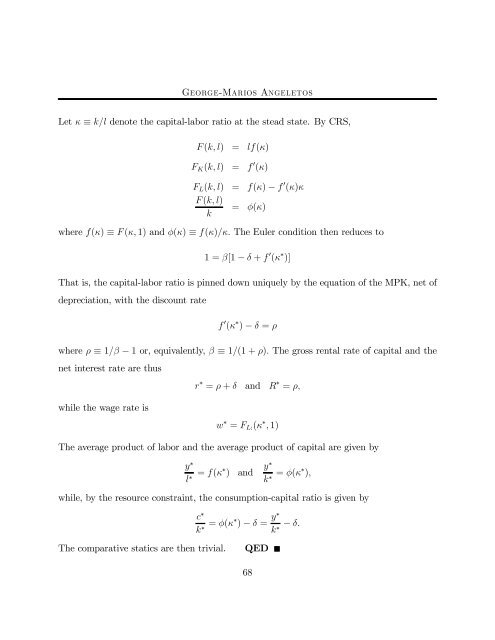14.451 Lecture Notes Economic Growth
14.451 Lecture Notes Economic Growth
14.451 Lecture Notes Economic Growth
Create successful ePaper yourself
Turn your PDF publications into a flip-book with our unique Google optimized e-Paper software.
George-Marios Angeletos<br />
Let κ ≡ k/l denote the capital-labor ratio at the stead state. By CRS,<br />
F (k, l) = lf(κ)<br />
FK(k, l) = f 0 (κ)<br />
FL(k, l) = f(κ) − f 0 (κ)κ<br />
F (k, l)<br />
k<br />
= φ(κ)<br />
where f(κ) ≡ F (κ, 1) and φ(κ) ≡ f(κ)/κ. The Euler condition then reduces to<br />
1=β[1 − δ + f 0 (κ ∗ )]<br />
That is, the capital-labor ratio is pinned down uniquely by the equation of the MPK, net of<br />
depreciation, with the discount rate<br />
f 0 (κ ∗ ) − δ = ρ<br />
where ρ ≡ 1/β − 1 or, equivalently, β ≡ 1/(1 + ρ). The gross rental rate of capital and the<br />
netinterestratearethus<br />
while the wage rate is<br />
r ∗ = ρ + δ and R ∗ = ρ,<br />
w ∗ = FL:(κ ∗ , 1)<br />
The average product of labor and the average product of capital are given by<br />
y ∗<br />
l ∗ = f(κ∗ ) and y∗<br />
k ∗ = φ(κ∗ ),<br />
while, by the resource constraint, the consumption-capital ratio is given by<br />
c ∗<br />
k∗ = φ(κ∗ ) − δ = y∗<br />
k<br />
The comparative statics are then trivial. QED<br />
68<br />
∗ − δ.

















